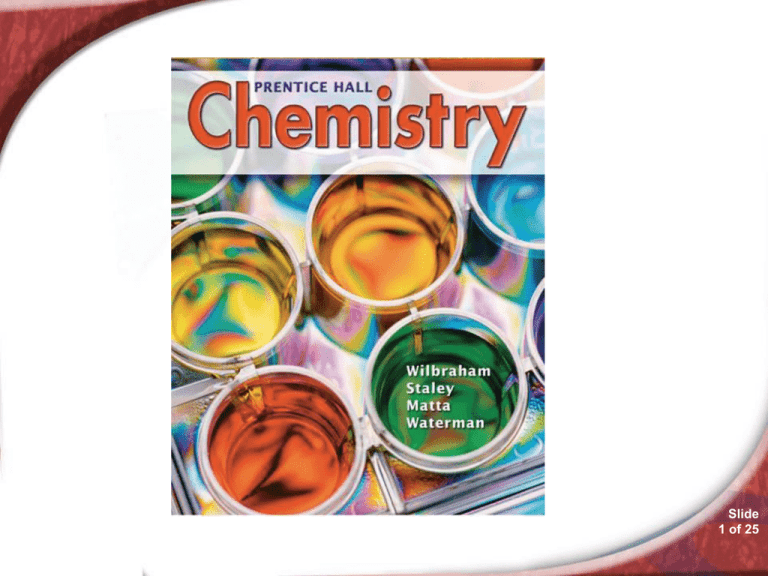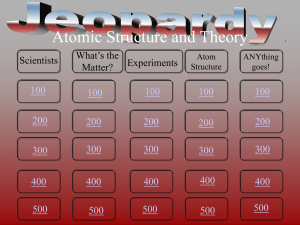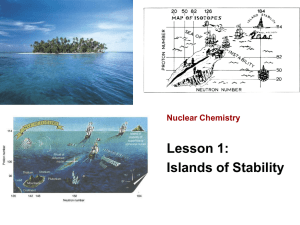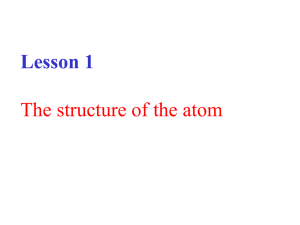
Chemistry 4.2
Slide
1 of 25
4.2
Structure of the Nuclear Atom
Cathode-ray tubes are
found in TVs, computer
monitors, and many other
devices with electronic
displays.
Slide
2 of 25
© Copyright Pearson Prentice Hall
4.2
Structure of the Nuclear Atom
>
Subatomic Particles
Subatomic Particles
What are three kinds of subatomic
particles?
Slide
3 of 25
© Copyright Pearson Prentice Hall
4.2
Structure of the Nuclear Atom
>
Subatomic Particles
Three kinds of subatomic particles are
electrons, protons, and neutrons.
Slide
4 of 25
© Copyright Pearson Prentice Hall
Structure of the Nuclear Atom
>
Cathode Ray Tube
William Crookes used a glass tube
that was used to study the relationship
between mass and charge.
Metal electrodes were placed in each end
of the tube. The metal plate that was
connected to the negative terminal of the
battery was called the cathode. Electrode
connected to the positive terminal was
called the Anode.
Slide
5 of 25
© Copyright Pearson Prentice Hall
Structure of the Nuclear Atom
>
Cathode Ray tube
Slide
6 of 25
© Copyright Pearson Prentice Hall
Structure of the Nuclear Atom
>
The Real thing!
Slide
7 of 25
© Copyright Pearson Prentice Hall
4.2
Structure of the Nuclear Atom
>
Subatomic Particles
Electrons
In 1897, the English physicist J. J. Thomson
(1856–1940) discovered the electron. Electrons
are negatively charged subatomic particles.
Slide
8 of 25
© Copyright Pearson Prentice Hall
Structure of the Nuclear Atom
>
In the mid-nineteenth century, Julius
Plücker investigated the light emitted in
discharge tubes (Crookes tubes) and the
influence of magnetic fields on the glow.
Later, in 1869, Johann Wilhelm Hittorf
studied discharge tubes with energy rays
extending from a negative electrode, the
cathode.
These rays produced a fluorescence when
they hit a tube's glass walls, and when
interrupted by a solid object they cast a
shadow.
© Copyright Pearson Prentice Hall
Slide
9 of 25
4.2
Structure of the Nuclear Atom
>
Subatomic Particles
Thomson performed experiments that involved
passing electric current through gases at low
pressure.
The result was a glowing beam, or cathode ray,
that traveled from the cathode to the anode.
Slide
10 of 25
© Copyright Pearson Prentice Hall
4.2
Structure of the Nuclear Atom
>
Subatomic Particles
Cathode Ray Tube
Slide
11 of 25
© Copyright Pearson Prentice Hall
Structure of the Nuclear Atom
>
In a cathode-ray tube, electrons travel as a
ray from the cathode (-) to the anode (+). A
television tube is a specialized type of
cathode-ray tube.
Slide
12 of 25
© Copyright Pearson Prentice Hall
Structure of the Nuclear Atom
>
Thomson examined two ways that a
cathode ray can be deflected: a) by using
a magnet, and b) by using electrically
charged plates. Inferring If a cathode ray
is attracted to a positively charged plate,
what can you infer about the charge of the
particles that make up the cathode ray?
Slide
13 of 25
© Copyright Pearson Prentice Hall
4.2
Structure of the Nuclear Atom
>
Subatomic Particles
A cathode ray is deflected by a magnet.
Slide
14 of 25
© Copyright Pearson Prentice Hall
4.2
Structure of the Nuclear Atom
>
Subatomic Particles
A cathode ray is deflected by electrically
charged plates.
Slide
15 of 25
© Copyright Pearson Prentice Hall
4.2
Structure of the Nuclear Atom
>
Subatomic Particles
Thomson concluded that a cathode ray is a
stream of electrons. Electrons are parts of the
atoms of all elements.
Slide
16 of 25
© Copyright Pearson Prentice Hall
4.2
Structure of the Nuclear Atom
>
Subatomic Particles
Protons and Neutrons
In 1886, Eugen Goldstein (1850–1930) observed
a cathode-ray tube and found rays traveling in
the direction opposite to that of the cathode rays.
He concluded that they were composed of
positive particles.
Such positively charged subatomic particles are
called protons.
Slide
17 of 25
© Copyright Pearson Prentice Hall
Structure of the Nuclear Atom
Goldstien canal tube
>
PerforatedCathode
Slide
18 of 25
© Copyright Pearson Prentice Hall
Structure of the Nuclear Atom
Electron in bottom
>
Protons are red
(Green)
Slide
19 of 25
© Copyright Pearson Prentice Hall
4.2
Structure of the Nuclear Atom
>
Subatomic Particles
In 1932, the English physicist James Chadwick
(1891–1974) confirmed the existence of yet
another subatomic particle: the neutron.
He work under Rutherford research.
Neutrons are subatomic particles with no
charge but with a mass nearly equal to that of a
proton.
Slide
20 of 25
© Copyright Pearson Prentice Hall
Structure of the Nuclear Atom
>
He devised a simple apparatus that
consisted of a cylinder containing a
polonium source and beryllium target.
The resulting radiation could then be
directed a material such as paraffin wax
and the particles displaced, which were
protons, would go into a small ionisation
chamber where they could be detected
with an oscilloscope.
Slide
21 of 25
© Copyright Pearson Prentice Hall
Structure of the Nuclear Atom
>
Slide
22 of 25
© Copyright Pearson Prentice Hall
Structure of the Nuclear Atom
>
Oscilloscope
Slide
23 of 25
© Copyright Pearson Prentice Hall
4.2
Structure of the Nuclear Atom
>
Subatomic Particles
Table 4.1 summarizes the properties of
electrons, protons, and neutrons.
Slide
24 of 25
© Copyright Pearson Prentice Hall
4.2
Structure of the Nuclear Atom
>
The Atomic Nucleus
The Atomic Nucleus
How can you describe the structure of
the nuclear atom?
Slide
25 of 25
© Copyright Pearson Prentice Hall
4.2
Structure of the Nuclear Atom
>
The Atomic Nucleus
J.J. Thompson and others supposed the atom
was filled with positively charged material and
the electrons were evenly distributed throughout.
This model of the atom turned out to be shortlived, however, due to the work of Ernest
Rutherford (1871–1937).
Slide
26 of 25
© Copyright Pearson Prentice Hall
4.2
Structure of the Nuclear Atom
>
The Atomic Nucleus
Ernest Rutherford’s Portrait
Born in New Zealand, Nobel Prize 1908
Slide
27 of 25
© Copyright Pearson Prentice Hall
4.2
Structure of the Nuclear Atom
>
The Atomic Nucleus
Rutherford’s Gold-Foil Experiment
In 1911, Rutherford and his coworkers at the
University of Manchester, England, directed a
narrow beam of alpha particles at a very thin
sheet of gold foil.
Slide
28 of 25
© Copyright Pearson Prentice Hall
4.2
Structure of the Nuclear Atom
>
The Atomic Nucleus
Rutherford’s Gold-Foil Experiment
Slide
29 of 25
© Copyright Pearson Prentice Hall
Structure of the Nuclear Atom
>
Gold Foil Experiment yield that an atomic
nucleus is present.
Most of the particles passed through but
some were deflect.
He measured the angle of deflection.
The experiment indicated the atom was
made mostly of space. The nucleus is
were the mass and positive charge is
concentrated. Nucleus deflected the
particles.
Slide
30 of 25
© Copyright Pearson Prentice Hall
4.2
Structure of the Nuclear Atom
>
The Atomic Nucleus
Alpha particles scatter from the gold foil.
Slide
31 of 25
© Copyright Pearson Prentice Hall
4.2
Structure of the Nuclear Atom
>
The Atomic Nucleus
The Rutherford Atomic Model
Rutherford concluded that the atom is mostly
empty space. All the positive charge and almost
all of the mass are concentrated in a small region
called the nucleus.
The nucleus is the tiny central core of an atom
and is composed of protons and neutrons.
Slide
32 of 25
© Copyright Pearson Prentice Hall
4.2
Structure of the Nuclear Atom
>
The Atomic Nucleus
In the nuclear atom, the protons and
neutrons are located in the nucleus.
The electrons are distributed around
the nucleus and occupy almost all the
volume of the atom.
Proton and neutrons 99% of mass
Electron make up 99% of volume
© Copyright Pearson Prentice Hall
Slide
33 of 25
4.2 Section Quiz
Assess students’ understanding
of the concepts in Section 4.2.
Continue to:
-or-
Launch:
Section Quiz
Slide
34 of 25
© Copyright Pearson Prentice Hall
4.2 Section Quiz
1. Which of the following is NOT an example of
a subatomic particle?
a. proton
b. molecule
c. electron
d. neutron
Slide
35 of 25
© Copyright Pearson Prentice Hall
4.2 Section Quiz
2. The nucleus of an atom consists of
a. electrons only.
b. protons only.
c. protons and neutrons.
d. electrons and neutrons.
Slide
36 of 25
© Copyright Pearson Prentice Hall
4.2 Section Quiz
3. Most of the volume of the atom is occupied
by the
a. electrons.
b. neutrons.
c. protons and neutrons.
d. protons.
Slide
37 of 25
© Copyright Pearson Prentice Hall
END OF SHOW








